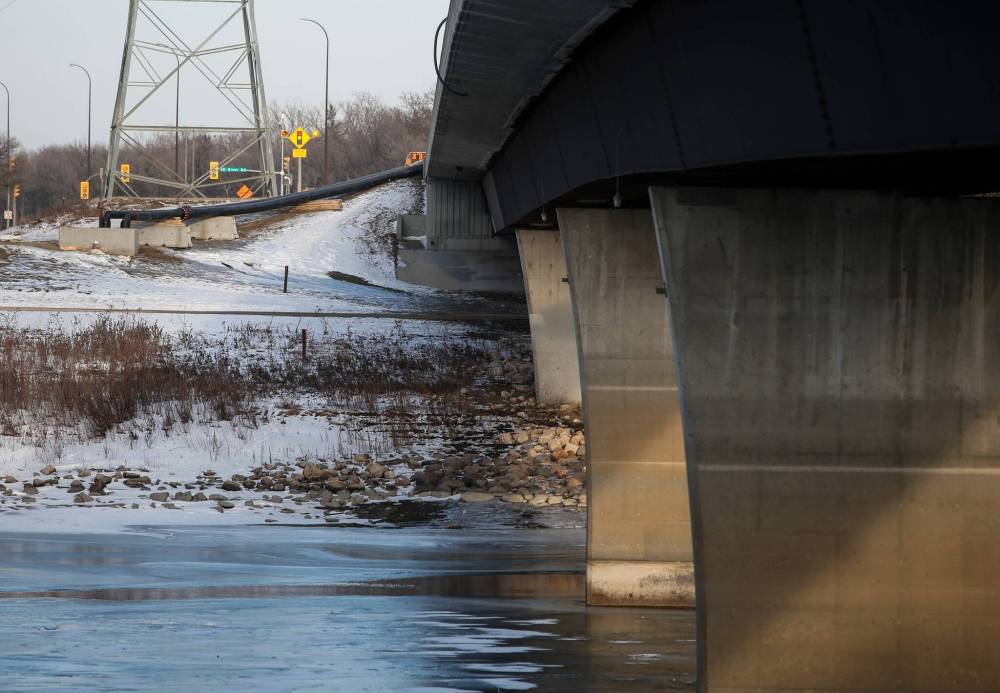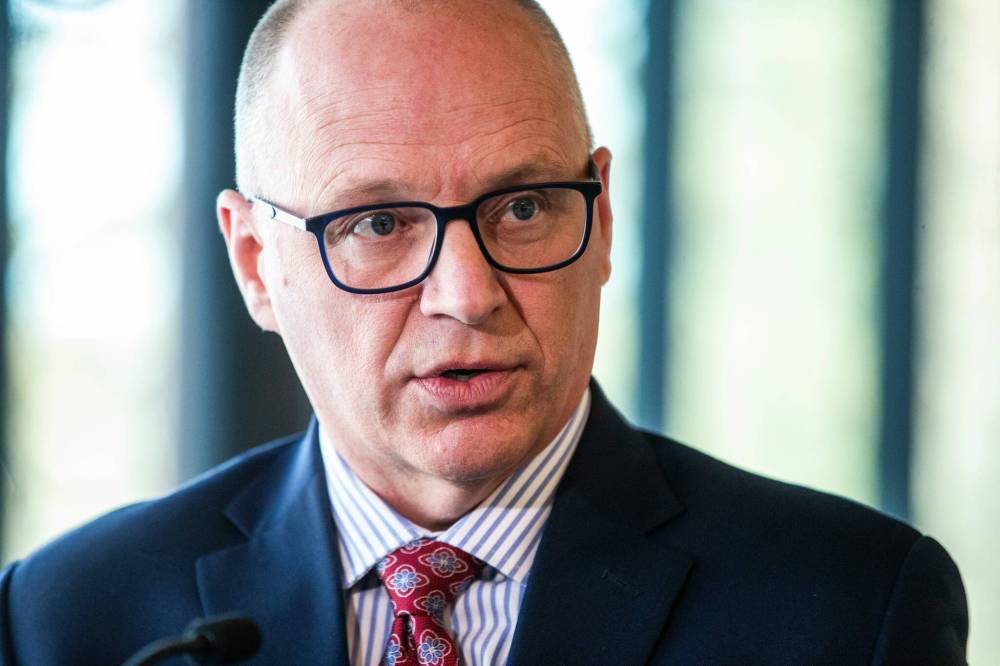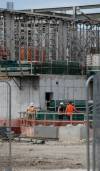City stops sewage flow into Red; lifts water-use caution
Advertisement
Read this article for free:
or
Already have an account? Log in here »
To continue reading, please subscribe:
Monthly Digital Subscription
$0 for the first 4 weeks*
- Enjoy unlimited reading on winnipegfreepress.com
- Read the E-Edition, our digital replica newspaper
- Access News Break, our award-winning app
- Play interactive puzzles
*No charge for 4 weeks then price increases to the regular rate of $19.00 plus GST every four weeks. Offer available to new and qualified returning subscribers only. Cancel any time.
Monthly Digital Subscription
$4.75/week*
- Enjoy unlimited reading on winnipegfreepress.com
- Read the E-Edition, our digital replica newspaper
- Access News Break, our award-winning app
- Play interactive puzzles
*Billed as $19 plus GST every four weeks. Cancel any time.
To continue reading, please subscribe:
Add Free Press access to your Brandon Sun subscription for only an additional
$1 for the first 4 weeks*
*Your next subscription payment will increase by $1.00 and you will be charged $16.99 plus GST for four weeks. After four weeks, your payment will increase to $23.99 plus GST every four weeks.
Read unlimited articles for free today:
or
Already have an account? Log in here »
Hey there, time traveller!
This article was published 23/02/2024 (658 days ago), so information in it may no longer be current.
The City of Winnipeg has successfully installed a bypass system near the Fort Garry Bridge to staunch the flow of sewage that has been streaming into the Red River for two weeks.
The city announced the development in a news release Friday, telling some 90,000 water customers in southwest Winnipeg they no longer have to make efforts to reduce their consumption.
“It’s good news,” Mayor Scott Gillingham told reporters at an unrelated news conference. “The system is working like it’s intended to work.”
According to city data, in excess of 228 million litres of sewage — enough to fill 91 Olympic-sized swimming pools — had flowed into the river since Feb. 7, when a pipe used to carry the putrid fluid through an underwater crossing failed.
City crews identified a leak in one of two pipes used at the site in November. They shut down the leaky pipe and diverted the sewage through the remaining one — incorrectly believing it could handle the flow.
JOHN WOODS / FREE PRESS FILES City crews work to bypass a sewage leak across the Red River at the Fort Garry Bridge on Tuesday. 
Crews rushed to install a bypass that included temporary piping and a pair of mechanical pumps to divert the waste.
The final bit of sewage spilled Wednesday at 12:13 a.m., the city said. At the time, only one of the pumps needed to support the system was operational. The second pump was running by Wednesday evening.
The bypass system will remain in place until the city can replace the faulty pipes beneath the waterway. Construction of the new infrastructure is expected to begin in 2025.
“I would like to see that expedited. I will be talking to our staff about that,” Gillingham said of the project, adding “everybody is frustrated” by the spill.
“Nobody wants to see this happen. We take this very seriously.”
Gillingham noted he remained in constant contact with city staff as they worked to address the leak. He met with Premier Wab Kinew to discuss the issue Friday, he said.
MIKAELA MACKENZIE / FREE PRESS “Nobody wants to see this happen. We take this very seriously,” Mayor Scott Gillingham said.
Earlier this week, Manitoba Environment Minister Tracy Schmidt confirmed the province has launched an investigation into the incident and is monitoring water quality in the Red River to assess potential environmental damage.
Raw sewage depletes oxygen levels in water bodies, threatening aquatic life.
A provincial spokesperson confirmed water conditions upstream and downstream from the spill are continuing to be monitored, but they would not elaborate on what initial water-quality test results are indicating.
Under provincial and federal regulations, the city could be subject to fines, pending the results of an investigation.
The provincial government charged the city with three counts of violating the Environment Act Licence in 2011. The parties ultimately reached a plea agreement in which the city was asked to pay $10,000 in court costs, the spokesperson said.
The city has not been fined by senior levels of government in any of the last five years, the city said.
The spill is among the largest of its kind to occur in Winnipeg, second only to a September 2002 disaster at Winnipeg’s North End sewage treatment plant that dumped 427 million litres of untreated waste into the Red.
Environment Canada laid charges against the city after the spill, but they were later stayed by a provincial court judge.
Prosecution under the Fisheries Act is the most common avenue by which federal regulators pursue charges in cases in which a municipality deposits harmful substances into water that is frequented by fish, said Winnipeg lawyer John Stefaniuk.
The maximum penalty under the act is $500,000.
Stefaniuk, whose practice includes an emphasis on environmental law, spoke generally about how such charges are usually handled.
“It’s not a complete shield, but it historically has offered some levels of protection.”–Lawyer John Stefaniuk said.
Municipalities typically hold a level of statutory protection, which offers some limitations on their liability, he said.
“It may have the effect of applying a higher standard of determining whether or not a municipality is liable for the damage that has been caused,” Stefaniuk said. “It’s not a complete shield, but it historically has offered some levels of protection.”
The most common defence used in the face of regulatory charges is based on the concept of due diligence, in which municipalities must prove having taken every reasonable action to prevent the pollutants from being released, he said.
City officials have repeatedly stressed the pipes near the Fort Garry Bridge were routinely inspected for deficiencies.
Civil cases, such as those filed by individuals or other municipalities in the wake of an environmental spill, require the plaintiff to prove they have suffered a financial loss or something that could be quantified as a financial loss as a result, Stefaniuk said.
“That’s sometimes more difficult to establish,” he said.
“We cannot bear the full cost of all these projects alone.”–Mayor Scott Gillingham
After the 2002 spill, the Clean Environment Commission ordered Winnipeg to create two new facilities at the North End plant. When asked whether the recent spill could lead to another major development for the city, Gillingham said it was too soon to comment.
He stressed that improving Winnipeg’s wastewater system, including completing the North End sewage treatment plant upgrade, will require additional financial support from senior levels of government.
When the project was announced, the three governments signed an agreement to fund the upgrade based on its previous $553-million price tag; Ottawa would cover 36 per cent and the province 30 per cent, with the city funding the balance.
Expected costs for the project have since soared to $2.3 billion.
“This is growth-enabling infrastructure. There’s a lot of focus right now on housing, as there should be… but you’ve got to have the sewer pipes and the sewer systems to accommodate that growth,” Gillingham said.
“We cannot bear the full cost of all these projects alone.”
Crews will continuously monitor the bypass system moving forward to ensure it is functioning properly. While it remains in place, speed limits on the Fort Garry Bridge will be reduced from 80 to 60 km/h, the city said.
Both eastbound lanes are now open, but at reduced width. Motorists can expect intermittent lane closures in the future, as crews work to maintain and make adjustments to the system, the city said.
tyler.searle@freepress.mb.ca

Tyler Searle is a multimedia producer who writes for the Free Press’s city desk. A graduate of Red River College Polytechnic’s creative communications program, he wrote for the Stonewall Teulon Tribune, Selkirk Record and Express Weekly News before joining the paper in 2022. Read more about Tyler.
Every piece of reporting Tyler produces is reviewed by an editing team before it is posted online or published in print — part of the Free Press‘s tradition, since 1872, of producing reliable independent journalism. Read more about Free Press’s history and mandate, and learn how our newsroom operates.
Our newsroom depends on a growing audience of readers to power our journalism. If you are not a paid reader, please consider becoming a subscriber.
Our newsroom depends on its audience of readers to power our journalism. Thank you for your support.












